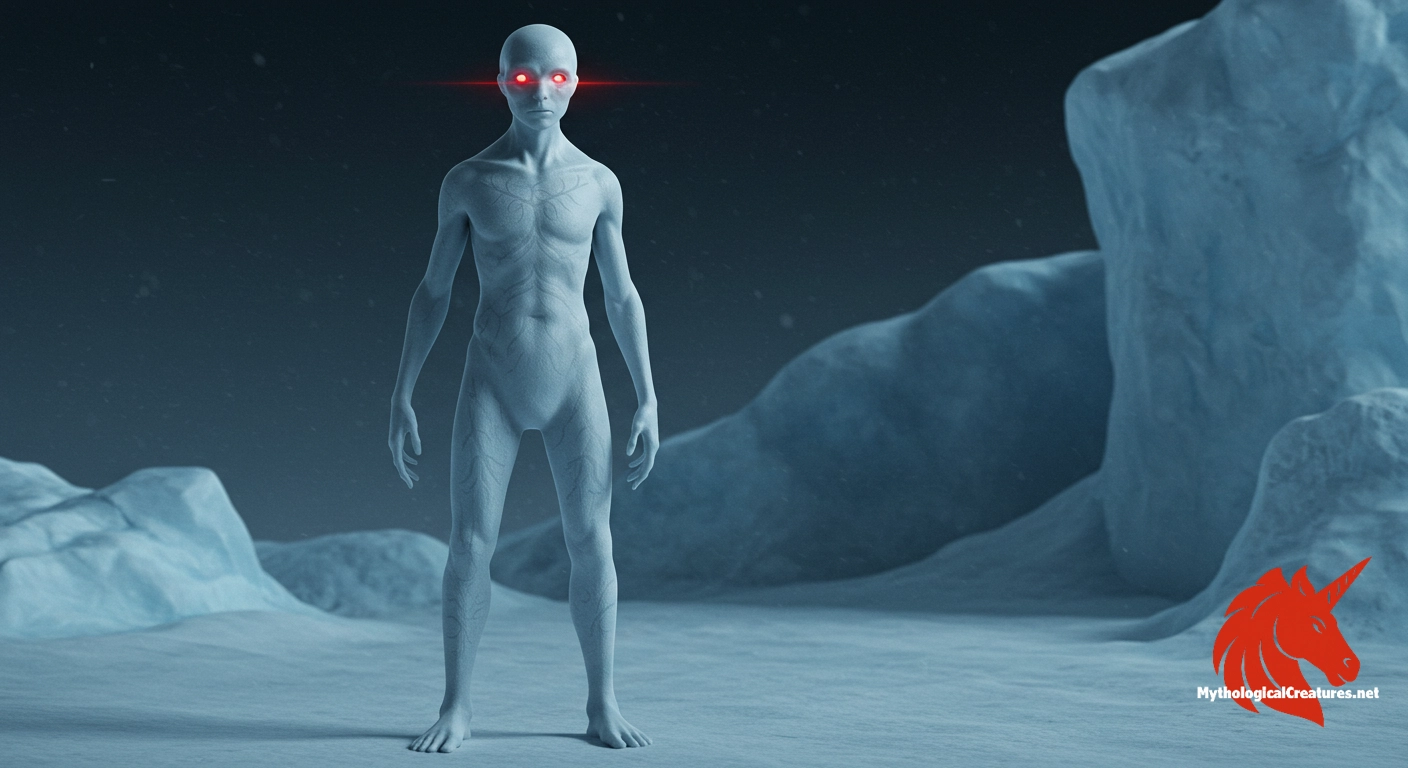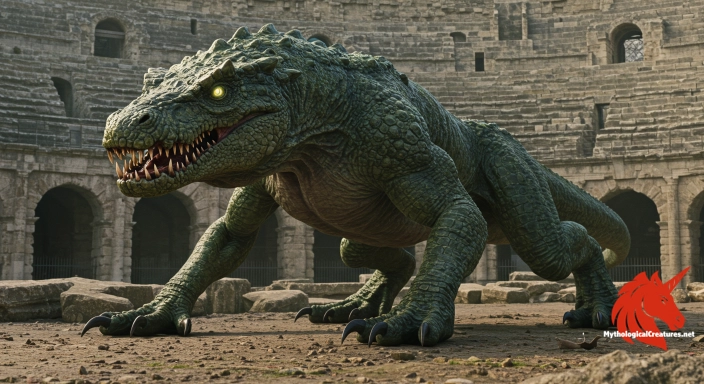Ijiraq: The ijiraq is a mysterious shapeshifting entity from Inuit mythology, known for abducting children.

Ijiraq
Ijiraq - Highlights the perilous and mysterious interactions between humans and the spirit world in Inuit culture.
Origins & First Encounters
Emerging from the stark beauty of the Arctic, the Ijiraq occupies a unique place in Inuit mythology, celebrated for its mystical ability to transform and its enigmatic presence. This creature, renowned for its power to abduct and mystify, has long been part of the oral traditions passed down through countless generations across icebound communities. Its origins are steeped in the cultural practices of the Inuit, where stories of otherworldly encounters were crafted to both caution and inspire. The Ijiraq is often portrayed as a fluid entity, one whose shifting form can mirror the capricious nature of the wilderness itself. Such narratives interlace elements of protection, danger, and the ever-present influence of nature, presenting an intricate tableau of belief and survival. The legend’s endurance is a testament to how deeply it resonates with the human condition amid the harsh realities of life in the far north. Over time, the myth has adapted to reflect evolving perceptions of the natural and spiritual world, solidifying its place as a symbol of transformation and mystery. This layered tapestry of lore continues to challenge and fascinate, urging a deeper appreciation of both nature’s beauty and its unpredictable power.
Source Texts & Tale Variants
The accounts of the Ijiraq have been lovingly preserved primarily through the vibrant tradition of oral storytelling among Inuit communities. Early collectors of indigenous lore recorded multiple variants, each adding delicate nuances to the creature’s notorious habit of abducting children. In some early narratives, the Ijiraq was depicted as a shape-shifter with ambiguous morality, capable of both cruelty and unexpected mercy. These oral traditions, passed along by elders, illustrate a complex character whose actions serve both as a warning and as a mirror to the unpredictable natural world. The subtle differences among the stories highlight regional influences and evolving attitudes towards nature and the supernatural. Some variations even suggest that, under certain circumstances, encounters with the Ijiraq could lead to a transformative journey rather than a dire consequence. The diversity of these recountings demonstrates that the myth is a living narrative, adapting alongside the cultural and environmental challenges faced by its people. As such, the treasure trove of folklore surrounding the Ijiraq offers a unique glimpse into the dynamic interplay between myth, nature, and community values.
Form & Powers
The Ijiraq is renowned for its remarkable ability to alter its physical appearance, embodying an ever-changing form that defies easy description. In some accounts, it emerges as a lithe, human-like figure with subtle, almost imperceptible hints of the wild, such as unusually sharp features or glistening eyes that reflect the icy glow of the Arctic. Other stories portray it as an amalgamation of human and animal traits, with limbs and features that shift fluidly according to its surroundings. Witness descriptions often evoke an eerie beauty, with a complexion that seems both unfathomably cold and unnervingly warm at the same time. Its form is frequently depicted as partially shrouded in a spectral aura or shifting layers of light and shadow, which allow it to blend almost seamlessly into the wintry landscape. Despite the variability in these descriptions, a common motif remains: the creature mirrors the unpredictable and mercurial nature of its frigid home. The Ijiraq’s physicality is thus not fixed but is a canvas upon which stories of both wonder and fear have been painted. This mutable presence continues to challenge perceptions, leaving behind an indelible impression of the mysterious forces that rule the Arctic night.
Regional Faces
Across the vast expanse of the Arctic, the legend of the Ijiraq accrues unique contours that vary from one Inuit community to another. In parts of the Canadian Arctic, for instance, the creature’s identity is closely intertwined with the inuksuk, serving as both a supernatural test and a symbolic guide to lost souls. Meanwhile, Inuit groups in other regions fashion the Ijiraq in their local dialects with subtle differences, sometimes depicting it as a solitary trickster that roams desolate landscapes rather than a direct kidnapper. The variations in its portrayal often mirror the environmental contexts, whether it is the coastal tundra or the inland ice fields, where natural features inspire complementary elements in the myth. These regional adaptations highlight local experiences with isolation, navigation, and the fragile balance between safety and peril in extreme conditions. Such diversity in narrative enriches the myth, endowing the Ijiraq with meanings that are as fluid as the creature itself. In every telling, the creature is a manifestation of both the environmental challenges and the quirky, resilient spirit of the local inhabitants. In this manner, regional lore not only diversifies the legend but also preserves a dynamic link between people and the daunting wilderness surrounding them.
Cultural Parallels
When the Ijiraq is examined alongside similar mythological beings around the world, it reveals striking parallels with other shapeshifters whose dual natures both beguile and caution. Its capacity to alter form brings to mind figures like the European faeries, whose supernatural transformations similarly play with the boundaries of reality and illusion. Comparable to the Scottish selkies, which shift from marine animals to humans, the Ijiraq exists at the intersection of the known and the mysterious, challenging the rigidity of human-determined identities. In many cultures, such creatures serve as metaphorical gatekeepers, testing the resilience and moral fibre of those who dare encounter them. These cross-cultural similarities underline a shared human fascination with stories where beauty intertwines with danger and benevolence with malevolence. Whether it is a warning against solitary wanderings or a symbolic representation of nature’s indomitable spirit, the Ijiraq resonates with similar archetypes found in global traditions. This universal motif underscores the human desire to understand variability and unpredictability in the forces that shape our lives. By comparing the Ijiraq with its international counterparts, one can appreciate how diverse communities seek to personify the qualities of change, mystery, and ethical caution through myth.
Legacy & Modern Evolution
Throughout the centuries, the myth of the Ijiraq has gracefully transformed from a strictly cautionary tale into a rich symbol of cultural identity and resilience. What began as a narrative warning aimed at protecting vulnerable community members has evolved to encompass themes of transformation and adaptability—a reflection of the ever-changing Arctic environment itself. In contemporary culture, the Ijiraq has been reimagined by artists, writers, and filmmakers, who draw upon its ambiguous allure to explore broader issues such as environmental conservation and cultural survival. Modern re-tellings often accentuate its dual role as both a harbinger of danger and a guardian of sacred, ancient wisdom. This evolution mirrors shifts in society, where traditional lore is increasingly seen not only as a repository of fear but also as a source of empowerment and identity. The enduring appeal of the Ijiraq is evident in its presence at cultural festivals, art exhibitions, and literature that celebrate indigenous heritage. As traditional beliefs meld with modern storytelling practices, the creature continues to serve as a bridge between the archaic and the contemporary. Its legacy, rich in metaphor and mystery, remains a powerful refrain that challenges and inspires those striving to preserve and revitalise cultural narratives in a modern world.
Interesting Fact
An inuksuk, traditionally used as a stone landmark in the Arctic, is believed to counteract the ijiraq’s malevolent power by guiding abducted children back to safety.
Quick Creature Info
Origin:
Features:
Associations:
Our Mythic Legendary Rating:

Also Sometimes Known As:
Habitat:
Supernatural Powers:
Physical Attributes:
Abilities:
Behavior:
Weaknesses:
Lore:
Related Creatures, Tales or Lore
- QQalupalik
- SSkin-walker
- PPukwudgie
References
Discover Another Mythical Legend You May Not Have Heard Of?
Uncover the mysteries of ancient folklore and expand your knowledge of legendary beings from cultures around the world.
Dare to Meet the Graoully....
Curated by the Mythological Creatures Team (rev. May 2025)
